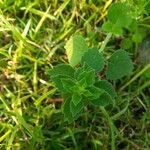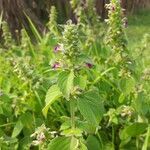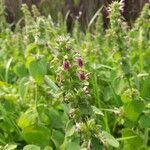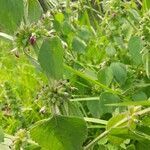Stems erect, 1-2 m tall, branched, densely appressed white pubescent. Petiole 1-4.5 cm; leaf blade broadly ovate, 4-9 × 2.5-6.5 cm, adaxially finely strigose especially on veins, abaxially densely white minutely tomentose, tomentose on veins, base broadly truncate-cuneate, margin irregularly dentate, apex acute or short acuminate. Spikes ca. 2.5 cm in diam.; floral leaves short petiolate or ± sessile, longer than verticillasters; bracts 3-4 mm. Calyx ca. 6 mm, hirsute, glandular pubescent, yellow glandular; teeth purple-red, triangular-lanceolate, ca. 2.7 mm, ciliate. Corolla purplish, ca. 1.3 cm, glabrous outside; tube funnelform, mouth to 3.5 mm wide; upper lip oblong, 4.5-5 × 3 mm, margin entire; lower lip subhorizontally spreading, ca. 9 × 5 mm; middle lobe obcordate, ca. 3 × 4.5 mm, slightly undulate, bearded; lateral lobes ovate. Ovary glabrous. Nutlets ca. 1.5 mm in diam. Fl. Aug-Sep, fr. Sep-Nov.
An erect herb. It has a bad smell. The leaves are broadly oval and 4-9 cm long by 3-7 cm wide. They have a white coating underneath. The leaves have round teeth along the edge. The flowers are in flat topped groups in the axils of leaves. The flowers do not have stalks. The flowers are bell shaped.




